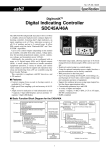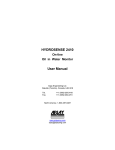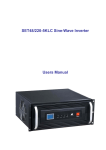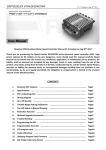Download F47 120V-750VA VSC
Transcript
Victor Electronics Ltd. Victor F47 120V-750VA VSC Voltage Sag Compensator User Manual Address: Victor Electronics Ltd., Room 9, 13/F., World Wide Industrial Centre, 43-47 Shan Mei Street, Fo Tan, N.T., Hong Kong Tel.: (852) 26871238 Fax: (852) 26871123 Website: www.victoronics.com Email: [email protected] Copyrights © 2009 Victor Electronics Ltd All Rights Reserved. Issue 4: 1 April 2009 Contents 1. Introduction ………………………………………………………...2 2. Principle of Operation ...…………………………………………..4 3. Technical Specifications (typical)...………………………..……..7 4. Protection against Abnormal Operation…………………………9 5. Simplified Test Procedure .………….…………………………..10 6. Threshold Voltage and Compensation Time Adjustments……12 Page1 1. Introduction AC operated electronic equipment are vulnerable to momentary losses of AC voltage, which are known as voltage sags. Voltage sags are commonly caused by lightning, accidental short circuit, loose connection, starting of large motors (or air-conditioners) or abnormal use of the AC mains. In sensitive and critical applications, such as semiconductor material processing and medical operation, voltage sags may result in serious problems. In order to tackle this problem, the Semiconductor Equipment and Materials International (SEMI) defined, in 1996, a voltage sag immunity standard, known as SEMI F47-0200, for semiconductor processing equipment manufacturers to conform to. Equipment compliant to this standard must have the specified immunity characteristics against voltage sags without the use of batteries. Based on the experience learned, the standard was redefined, in 2006, as SEMI F47-0706. It is expected that new semiconductor processing equipment will be designed to be compliant to the new standard. It is also likely that the SEMI F47-0706 requirement will be extended to other application areas. Victor’s F47 Series of Voltage Sag Compensators have been developed jointly by Victor Electronics and The Hong Kong Polytechnic University to provide sine-wave AC backup power to enable electronic equipment to meet the SEMI F47-0706 standard and to tolerate 100% momentary loss of AC mains voltage (or momentary open circuit in the AC line). It should be noted that, although uninterruptible power supplies (UPS) can be used to solve voltage sag problems in computers, it is not a suitable solution for many applications due to the following reasons: (1) A battery has to be used in a UPS. The acid, lead and other particles from a battery can be harmful to the operating environment. (2) The maintenance of the battery being used and the disposal of used batteries can introduce problems. (3) The output of a low-cost UPS is often a rectangular-wave voltage (instead of a sine-wave voltage). This is undesirable for many applications. Page2 (4) There are often inductive loads in the electronic equipment. Normally a low-cost UPS would not allow inductive loads. (5) The slow transfer time of low-cost UPS may cause sensitive relays or contactors to chatter. In areas where UPS or batteries are not acceptable, Voltage Sag Compensators can be used to minimize the undesirable effects of voltage sags. Page3 2. Principle of Operation Fig. 1 shows a simplified schematic diagram of the Victor F47 Voltage Sag Compensator. Vac SW D1 D3 L1 Vo Q3 Q1 V1 C3 C1 D5 Boost Regulator High-side Driver Load L3 C5 Q2 C2 C4 Q4 Boost Regulator Low-side Driver D6 D2 D4 L2 Inverter High-side Driver Microcomputer Controller Inverter Low-side Driver Fig.1 Simplified schematic diagram of Victor F47 Sag Compensator In Fig. 1, D1 and C1 form a rectifier to provide positive power supply to the positive boost regulator composed of L1, Q1, D3, and C3. D2 and C2 form a rectifier to provide negative power supply to the negative boost regulator composed of L2, Q2, D4, and C4. Q3, Q4, D5, D6, L3, and C5 (together with the related drivers) form a DC to AC inverter. The Microcomputer Controller monitors the AC mains and controls the operation of the DC to AC inverter. During normal operation the AC mains is connected to the load through the relay switch SW. The Inverter High-side and Low-side Drivers of the DC to AC inverter are disabled, so that the inverter output transistors Q3 and Q4 are turned off. When a voltage sag in the AC mains is detected by the Microcomputer Controller, the relay switch SW is opened. The DC to AC Inverter is then Page4 enabled to generate a back up AC voltage (sine-wave) for a preset period of time (adjustable from 0.25s to 2s). Within this period, the Inverter provides sine-wave AC power to the load. At the end of the preset period (nominally preset to 2s), the inverter is disabled and the microcomputer switches the load back to the AC mains. In Victor F47 Voltage Sag Compensators, the following new technologies have been developed to minimize the adverse effects of voltage sags: (1) The technology of storing up energy in large capacitors and, when there is a sag in the AC mains, converting most of the stored energy to AC back-up power. (2) The technology of using a microcomputer controller to fast detect the occurrence of voltage sag and to control the operation of the DC to AC (sine-wave) inverter. (3) The technology of fast switching the load between the AC mains and the DC to AC inverter, while maintaining practically zero conduction loss during normal operation. (4) The technology of minimizing the chattering of AC relays/contactors in the loading circuit using software techniques. It should be noted that a very important task of the sag compensator is to ensure that the operation of AC relays/contactors in the loading circuit will not be affected by the transfer operation between the AC mains and the DC to AC inverter during the voltage sag period. It is well known that the transfer operation often results in chattering of contacts. Chattering can be minimized by reducing the transfer time. However, our study indicates that if the software that drives the AC to DC inverter is designed properly the relay/contactor can tolerable a much slower transfer time without chattering. In other words, chattering can be efficiently minimized by software. In order to design proper software to reduce the chance of chattering, it is necessary to understand the dynamic behavior of relays/contactors. However such behaviors of AC relays/contactors under transient conditions (during the Page5 transfer operation) are difficult to analyze because of the following reasons: (1) In order to ensure that the energized solenoid will not drop out during the zero-crossing region of the AC driving current, the solenoid of an AC relay/contactor is split into two halves. On half of it has effectively a one-turn short-circuit secondary winding. This makes the analysis of the transient behaviors of AC relays/contactors complex. (2) The energizing coil of AC relay/contactor is inductive and the exact current waveform of the effective energizing current of the solenoid under transient condition is difficult to determine. In the design of the voltage sag compensator, extensive computer simulations have been used in Victor Electronics to analyze the behaviors of AC relays/contactors and to tailor-make software to minimize chattering during transfer periods. Page6 3. Technical Specifications (typical) Nominal AC Input Voltage: 120V Maximum AC Input Voltage: 132V Input Frequency: 50/60 Hz, auto-sensing Output Capacity: 750VA Voltage Drop due to Compensator (full load) : < 0.5V Efficiency: 99% at full load (under no voltage sag condition) Full Load Current: 6.25A (The load can be resistive, capacitive, or inductive.) Inrush Current: 50A Ride-through Time: (1) Exceeds the SEMI F47-0706 standard, which is shown in Table 1. Sag depth* Duration at 50Hz Duration at 60Hz Time 50% 10 cycles 12 cycles 0.2 second 70% 25 cycles 30 cycles 0.5 second 80% 50 cycles 60 cycles 1 second Table 1 SEMI F47-0706 Standard *Sag depth is expressed in percent of remaining nominal voltage. For example, a sag depth of 80% for 120V AC means that the voltage is reduced to 96V. (2) Even under the condition of zero AC input voltage or open-circuited input, meets the ride-through time requirement of one second minimum at full load with load power factor of 0.25. Page7 Voltage Sag Compensation Response Time: 4 milliseconds (including detection time) Sag Compensation Threshold Voltage: Adjustable from 85V to 115V in steps of 5V; factory preset to 100V. (See Paragraph 6 for details.) Sag Compensation Time: Adjustable from 0.25s to 2s in steps of 0.25s; factory preset to 2s. (See Paragraph 6 for details.) Waveform of Output Voltage: Sine-wave, with Total Harmonic Distortion < 8% Fail Safe Mode: The unit will not drop the load in the event the DC to AC inverter in the unit fails. Recharge Time (for the energy storage capacitors to charge up again): 3 seconds Indicators: AC Mains Input (green), Compensator AC Output (amber), and Inverter Output (red) Output voltage variation (for the range of Operating AC Input Voltage from 105V to 125V and load variation from no load to full load): 105V to 125V Page8 4. Protection against Abnormal Operation Under abnormal operating conditions, the DC to AC inverter in the Sag Compensator may be repetitively started to compensate the AC mains voltage. A typical example of abnormal condition is that the AC mains voltage is consistently below the threshold compensation level. Under such condition, the Sag Compensator will initially compensate the AC mains voltage for 2 seconds and then reconnect the load to the AC mains for 3 seconds. If the AC mains voltage is then still below the threshold compensation level, the compensator will begin another cycle of “2-second compensation followed by 3-second back to the AC mains”. However, if the repetitive rate of the compensation cycle is more than 4 times in every minute, the Sag Compensator may enter a protective mode operation. Under this mode of operation, the sag compensator will stop the compensation operation for 2 minutes, waiting the heat-generating components in the Sag Compensator to cool down. Within this 2-minute period, the load will be connected to the AC mains without compensation. At the end of the 2-minute period, the sag compensator will start another round of effort to compensate the AC mains voltage, as mentioned above. The Sag Compensator can stay in the protective mode of operation indefinitely without damage. As a further protective measure, it is recommended that a circuit breaker be used with the Compensator for protection against overloading. The current rating of the circuit breaker should be about 150% of the maximum current rating of the sag Compensator. Page9 5. Simplified Test Procedure In order to fully test the performance of the Voltage Sag Compensator, a programmable AC source (with galvanic isolation from the AC mains), an oscilloscope, and a programmable load are required. However, even without such sophisticated equipment, a simplified functional test can still be performed through the following procedures: (1) Under power-off condition, connect the AC mains (120V) through an external ON/OFF switch to the Sag Compensator, which is shown in Fig. 2, where G is the Ground terminal L is the Live terminal N is the Neutral terminal Do not confuse the live line (L) with the neutral line (N) from the AC mains. For simple testing, it is not necessary to connect any load to the output terminal of the Compensator. Keep the ON/OFF switch in the OFF position initially. INPUT OUTPUT G L N N L G ON 1 ON 2 3 1 2 3 Compensation Time Selector Threshold Voltage Selector Fig. 2 Rear panel of Sag Compensator (2) After checking the circuit, turn the ON/OFF switch to the ON position. The green “AC Mains Input” indicator and the amber “Compensator AC Output” indicator on the front panel of the Sag Compensator, as shown in Page10 Fig. 3, will then be lit up. AC Mains Input Compensator AC Output Inverter Output Fig. 3 Front panel of Sag Compensator (3) Wait for 10 seconds to allow the Microcomputer Controller in the Sag Compensator to complete its initiation process. (4) Manually simulate a one-second complete AC mains power failure by turning the ON/OFF switch to the OFF position for about one second, and then returning it back to the on position again. Check that the amber “Compensator AC Output” indicator remains lit up without interruption, indicating that there is no interruption in the AC output voltage. Also check that the red “Inverter Output” indicator is lit up for two seconds (assuming that the compensation time is preset to 2s), indicating that the Inverter has worked for two seconds to compensate for the voltage sag. (5) After a voltage sag simulation, as described in (4), it is necessary to wait for 3 seconds after the Inverter has stopped operation (as indicated by the extinguished red “Inverter Output” indicator) to allow the energy-storage capacitors to charge up again, before performing the next sag simulation. The above-mentioned test procedure is for the purpose of testing the functionality of the Sag Compensator only. If an oscilloscope is to be used to observe the output waveform of the Compensator, an isolation transformer should be used to provide galvanic insulation between the AC mains and the Sag Compensator. Warning: The high voltage on the energy-storage capacitors in the Compensator may take up to 1 hour to discharge to a safe value. Page11 6. Threshold Voltage and Compensation Time Adjustments The Sag Compensation Threshold Voltage of the Voltage Sag Compensator can be adjusted from 85Vac to 115Vac in steps of 5Vac, as shown in Table 2. The factory default setting is 100Vac (ON-OFF-OFF). The Sag Compensation Time of the Voltage Sag Compensator can be adjusted from 0.25sec to 2.00sec in steps of 0.25sec, as shown in Table 3. The factory default setting is 2.00 sec (ON-ON-ON). Warning: Turn off the power when changing the positions of the selector switches. Threshold Voltage Selector (SW1) VTH Compensation Time Selector (SW2) SW1_1 SW1_2 SW1_3 TCOMP SW2_1 SW2_2 SW2_3 115Vac ON ON ON *2.00s ON ON ON 110Vac ON ON OFF 1.75s ON ON OFF 105Vac ON OFF ON 1.50s ON OFF ON *100Vac ON OFF OFF 1.25s ON OFF OFF 95Vac OFF ON ON 1.00s OFF ON ON 90Vac OFF ON OFF 0.75s OFF ON OFF 85Vac OFF OFF ON 0.50s OFF OFF ON 100Vac OFF OFF OFF 0.25s OFF OFF OFF * Factory default setting Table 2 Threshold Voltage Selector * Factory default setting Table 3 Compensation Time Selector -ENDPage12


































